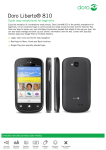Download Untitled
Transcript
Guida rapida - Italiano............ 5 Quick guide - English............ 21 Kurzanleitung - Deutsch....... 37 Guía rápida - Español............ 53 Guide rapide - Français......... 69 4 ITALIANO Guida rapida - Italiano ITALIANO 5 TM Benvenuti nel mondo di NGM Android . Grazie per aver acquistato NGM Dynamic Racing 2. Con questo dispositivo potrete avere accesso alle molteplici TM funzionalità del sistema operativo Android 4.2.2 Jelly Bean per gestire i vostri contatti, email, i social network e per scoprire le opportunità della rete Internet con un solo tocco! Esplorate tutte le potenzialità del vostro nuovo telefono “intelligente”. Rispetto agli Smartphone mono SIM, NGM Dynamic Racing 2 offre la comodità del Dual SIM che da sempre caratterizza l’intera gamma dei telefoni NGM, ovvero la possibilità di gestire due SIM e conseguentemente due numeri telefonici contemporaneamente. Scoprirete delle funzioni utilissime come l’impostazione della SIM preferita per le chiamate, le videochiamate, i messaggi e la connessione dati. Visitando il sito ufficiale www.ngm.eu potrete conoscere l’intera gamma di telefoni NGM, provare il nostro pratico e funzionale servizio di e-commerce per acquistare telefoni ed accessori, richiedere assistenza, accedere al forum di assistenza tecnica e scaricare aggiornamenti software. Attenzione: la connessione Dati di NGM Dynamic Racing 2 è attiva al momento della prima accensione del telefono (oppure dopo ciascun eventuale ripristino delle impostazioni di fabbrica). Se non si dispone di una tariffa agevolata o “flat” per la connessione dati con la propria USIM, si consiglia di disattivare il traffico dati e configurare una connessione Wi-Fi, al fine di evitare costi aggiuntivi. 6 ITALIANO D Assemblaggio Attenzione: eseguite tutte le operazioni di inserimento schede SIM e scheda di memoria soltanto dopo aver rimosso la batteria per non rischiare la perdita di dati. Inserire le USIM card: le USIM contengono i vostri numeri telefonici, i codici PIN, i collegamenti ai servizi esterni, contatti e altri importanti dettagli. Per accedere al vano contenente gli slot delle USIM, spegnete il telefono e sollevate la cover a partire dalla apposita fessura sul lato inferiore del telefono. Rimuovete la batteria ed inserite le schede USIM nei rispettivi slot con i contatti dorati rivolti verso il basso. Inserire la scheda di memoria: Per sfruttare tutte le funzioni di NGM Dynamic Racing 2, si consiglia l'utilizzo di una micro-SD che va collocata nella parte posteriore del telefono. Dopo aver spento il telefono, rimuovete la cover posteriore e la batteria, sollevate lo sportellino metallico del suo slot spingendolo in direzione OPEN. Inserite la micro-SD, come in figura, con i contatti dorati rivolti verso il basso. Bloccate infine lo sportellino spingendolo in direzione LOCK. Slot micro SD Slot 1: USIM 1 Slot 2: USIM 2 ITALIANO 7 Inserire la batteria Il vostro apparecchio è fornito con una batteria a ioni di litio ed è progettato per l’uso esclusivo di batterie e accessori originali NGM. La batteria va collocata nella parte posteriore del telefono. Inserite la batteria nel vano batteria con i contatti rivolti verso l’alto, in corrispondenza di quelli del telefono. Successivamente, ripristinate la cover posteriore del telefono, come mostrato qui di seguito. 8 ITALIANO Caricare la batteria Caricate la batteria prima di iniziare ad utilizzare l’apparecchio. Utilizzate il cavo USB in dotazione ed il connettore USB posto sul lato inferiore del telefono. Connettete il caricatore ad una presa della rete elettrica e quindi il dispositivo al cavo USB. Si può caricare il telefono anche collegandolo con il PC, ma in questo caso la carica sarà più lenta. Quando la batteria è in carica, un’icona animata sullo schermo mostra lo stato di avanzamento del processo se il telefono è acceso. Una volta che l’icona della batteria è riempita, la carica è completata e il telefono può essere disconnesso dalla rete elettrica. Attenzione: Non collegate il telefono ad un computer che si sta accendendo o spegnendo per evitare sbalzi di tensione. Per preservare la corretta funzionalità del prodotto e l'integrità della garanzia si raccomanda l'utilizzo di caricabatterie originali NGM. Procedete alla ricarica esclusivamente al coperto e in luoghi asciutti. Un leggero riscaldamento del telefono durante il processo di ricarica è del tutto normale. La batteria raggiungerà la sua piena efficienza funzionale solo dopo alcuni cicli completi di ricarica. Accensione, spegnimento e standby Per accendere il dispositivo, tenete premuto il tasto on/off. Per spegnere il dispositivo, tenete premuto lo stesso tasto e confermate lo spegnimento selezionando “Spegni”. Una pressione breve permette invece di passare rapidamente alla modalità di standby (schermo spento) o di tornare da questa allo schermo di sblocco (vedi sotto). ITALIANO 9 Schermata di Standby La schermata principale Usate il touch screen toccando, tenendo premuto o trascinando un dito sullo schermo. La schermata principale è il punto di partenza per l'utilizzo di tutte le applicazioni del telefono cellulare. Altre pagine si trovano affiancate rispetto a quella principale, alle quali si può accedere scorrendo verso destra e sinistra. Queste pagine sono personalizzabili con collegamenti alle applicazioni preferite: tenere premuto il Tocca e trascina collegamento desiderato dal menu principale e rilasciarlo sul l’elemento centrale Desktop. Potete personalizzare anche i quattro collegamenti per sbloccare accanto all’icona centrale del menu tenendoli premuti e spostandoli sul desktop. Per eliminare collegamenti o widget, tenete premuta l’icona e trascinatela verso il simbolo “X Rimuovi” in alto sullo schermo. Spostando un’icona sopra ad un’altra si creano delle cartelle sul desktop e premendo il menu contestuale si può cambiare lo sfondo. Il Menu principale Selezionate un’applicazione dal menu principale o scorrete verso sinistra/destra per visualizzare altre applicazioni. Premete il tasto indietro per tornare alla schermata precedente; premere il tasto Home per tornare alla schermata principale, premere il menu contestuale per creare cartelle ed accedere alle impostazioni del telefono. 10 ITALIANO Schermata Principale Intensità segnale USIM e livello batteria Menu Principale Pannello di notifica Intensità segnale WiFi Telefono Rubrica Menu Principale Messaggi Barra indicatore pagine Internet Scorrimento schermate HOME Scorrimento menu ITALIANO 11 Ingresso auricolare Fotocamera frontale Sensori di luminosità e prossimità Fotocamera Flash Ricevitore Tasto On/Off e standby Touch screen capacitivo Tasto menu contestuale Tasto Home Tasto indietro Microfono Connettore Micro USB 12 ITALIANO Volume “+”/“-“ Speaker SCELTE RAPIDE Pannello di notifica: per aprire il pannello di notifica, toccate l’area delle icone nella parte alta dello schermo e trascinate il dito in basso. Toccate l’icona in alto a destra per passare dalle notifiche ai pulsanti di impostazione rapida oppure toccate l’icona impostazioni per aprire il menu Impostazioni del telefono. Per nascondere il pannello, trascinate in alto la parte inferiore del pannello oppure toccate il tasto indietro. Applicazioni recenti: quando vi trovate all’interno di una qualsiasi applicazione, tenere premuto il Tasto Home: verrà visualizzato l’elenco delle applicazioni a cui avete effettuato l'accesso di recente; direttamente selezionabili. Menu contestuale: molte applicazioni prevedono l’utilizzo del tasto Menu Contestuale. Premendo su tale tasto, è possibile visualizzare un menu contestuale riferito all’applicazione stessa con le relative funzioni. Blocco schermo e vibrazione: dal menu principale, selezionare Impostazioni > Sicurezza > Blocco schermo. Selezionare la modalità desiderata (Nessuno, Slide, Sblocco vocale, Sequenza, PIN oppure Password) e confermare. Per bloccare rapidamente lo schermo, premere brevemente sul tasto di on/off del telefono. Per sbloccare lo schermo, seguire le indicazioni sullo schermo. Attivare o disattivare rapidamente la vibrazione: Per disattivare velocemente la suoneria per chiamate e messaggi tenere premuto il tasto volume “–“. Una volta raggiunto il volume minimo, il telefono entrerà in modalità vibrazione. Premendo nuovamente volume “–“, il telefono entrerà in modalità silenziosa. ITALIANO 13 Gestire le due USIM Dal menu principale, selezionare Impostazioni > Gestione SIM. Selezionare o deselezionare on/off accanto agli operatori telefonici corrispondenti a “USIM1” e “USIM2” per attivare o disattivare selettivamente le USIM in qualsiasi momento. Da questo menu è anche possibile personalizzare il colore e nome da attribuire all’icona di ciascuna USIM e decidere quale USIM usare come predefinita per chiamate, videochiamate, messaggi e connessione dati oppure scegliere “chiedi sempre” se non si desidera impostare una SIM predefinita. 3G Dinamico: in Impostazioni > Altro > Reti Mobili > Servizio 3G > Attiva 3G, è possibile selezionare la SIM su cui impostare il servizio 3G. Si tratta di una funzionalità innovativa che permette di spostare da una SIM all’altra il 3G, di solito confinato esclusivamente allo slot 1, senza doverle fisicamente invertire. GESTIRE UNA CHIAMATA Dalla schermata principale, toccare l’icona Telefono; digitare il numero telefonico da chiamare usando la tastiera virtuale. Premere l’icona cornetta e poi la SIM desiderata se non avete impostato una SIM predefinita per le chiamate, in caso contrario, la chiamata partirà con la SIM predefinita. Per terminare, toccate l’icona rossa di fine chiamata. Per rispondere ad una chiamata, trascinare la cornetta centrale verso destra sulla cornetta verde; per rifiutarla, trascinarla verso sinistra sulla cornetta rossa, per rifiutare tramite messaggio portare la cornetta verso l’alto. Per silenziare una chiamata in arrivo, toccare il tasto Volume “+” o “–“ (sul lato sinistro del telefono). 14 ITALIANO Richiamare un numero dal registro chiamate Dal menu principale, selezionare l’icona Telefono, quindi l’icona con l’orologio al centro per visualizzare il registro chiamate con le chiamate perse, ricevute e in uscita. Selezionare il numero desiderato e scegliere con quale USIM avviare la chiamata. GESTIRE CONTATTI Note: Nel menu contestuale della rubrica si ha accesso alle funzioni di importazione/esportazione dei contatti e varie impostazioni utili. Aggiungere un nuovo contatto Dal menu principale, selezionare l’icona Contatti. Premere l’icona sulla barra in basso a destra. Scegliere dove si intende salvare il nuovo contatto (account, telefono, USIM1 o USIM2). Inserire Nome, Numero ed eventuali altri dettagli del contatto (se il contatto viene salvato sulle USIM non è garantito il salvataggio di eventuali ulteriori dettagli oltre a nome e numero telefonico) e confermare il salvataggio. Aggiungere un nuovo contatto dal registro chiamate Dal menu Telefono, accedere al Registro Chiamate (icona con l’orologio). Premere sull’immagine di contatto del numero che si intende salvare tra le chiamate perse, effettuate o ricevute e confermare OK. Scegliere Crea Nuovo contatto sulla barra in basso oppure aggiungere il numero ad un Contatto esistente scegliendolo dall’elenco. Dopo aver selezionato il percorso di salvataggio ed aggiunto nome ed eventuali altre informazioni (se si salva sul Telefono), confermare con Salva. ITALIANO 15 E’ possibile associare i contatti in rubrica ad una delle due SIM per chiamare automaticamente i contatti con la SIM attribuita; per associare un contatto ad una delle due SIM inserite, premete il menu contestuale del contatto e scegliete Associa scheda SIM oppure da Impostazioni > Gestione SIM, scegliere Associazione Contatti, selezionare la SIM e scegliere dalla Rubrica i contatti da associare a quella SIM. Per rendere effettive le associazioni, attivare la funzione “Smart Dial” in Impostazioni > Gestione SIM > Associa contatti a SIM Impostare le suonerie Note: è possibile utilizzare come suonerie dei file nei formati *mid,*wav,*ogg o *mp3. Dal menu principale, selezionate Impostazioni > Profili Audio > Generale Selezionate Suoneria SIM1 o SIM2 e scegliete la suoneria desiderata per ciascuna USIM. Se si desidera impostare una suoneria personalizzata: in Musica selezionate il brano audio desiderato con una pressione prolungata e scegliete Usa come Suoneria nel menu contestuale. Così questo file audio sarà inserito nell’elenco delle suonerie disponibili. Inviare e leggere SMS e MMS Inviare SMS e MMS Dalla pagina o menu principale, scegliete Messaggi e quindi l’icona in basso a sinistra. Digitate le prime lettere di un nome nel campo destinatario per ricercare un contatto e selezionarlo dall’elenco pop-up oppure inserite direttamente il numero del destinatario, altrimenti selezionate l’icona Contatti accanto al campo e spuntate il/i destinatari. Inserite il testo nell’apposito spazio con la tastiera virtuale. Selezionate l’icona con il “+” per includere eventuali allegati multimediali (il messaggio sarà convertito in MMS) e premete Invio scegliendo la USIM desiderata. 16 ITALIANO Leggere SMS e MMS Quando ricevete un nuovo SMS o MMS, viene visualizzata una icona nel pannello di notifica. Cliccando sull’icona visualizzata, è possibile accedere direttamente alla conversazione e leggere il messaggio in arrivo. In ogni caso, è possibile visualizzare i messaggi in arrivo dallo schermo principale o dal menu, selezionando Messaggi. CONNETTIVITÀ Per utilizzare al meglio le potenzialità offerte dal terminale e dal suo sistema operativo, è necessario avere una connessione dati attiva; la connessione Dati di NGM Dynamic Racing 2 è attiva al momento della prima accensione del telefono. Se non previsto in abbonamento, il traffico dati implica dei costi; si consiglia quindi di configurare l’accesso Internet tramite WiFi. Per abilitare il traffico dati su una delle USIM, selezionate Impostazioni > Gestione SIM > Connessione dati, o attivarla con il pulsante di impostazione rapida nel pannello di notifiche. Connettersi a Internet con la funzione Wi-Fi® Potete collegarvi alla rete WLAN utilizzando la funzione Wi-Fi. Per attivarla, dal menu principale scegliere Impostazioni > WiFi. Attenetevi a tutte le avvertenze e le indicazioni specificate dal personale autorizzato quando vi trovate in aree in cui l’uso dei dispositivi wireless è limitato (aeroplani, ospedali ecc.). Passate alla Modalità offline quando dovete utilizzare solo i servizi che non richiedono l’accesso alla rete. ITALIANO 17 Connettersi a un dispositivo Bluetooth®: accendere il dispositivo Bluetooth al quale si desidera collegarsi. Riferirsi alla documentazione del dispositivo. Dal menu principale, scegliere Impostazioni > Bluetooth on/off per attivare il Bluetooth. Nel menu contestuale trovate ulteriori funzioni ed impostazioni. Scegliere Cerca dispositivi per avviare automaticamente la ricerca di dispositivi Bluetooth Tra i dispositivi rilevati, selezionare il nome del dispositivo da associare. Il telefono tenterà di associarsi al dispositivo, eventualmente verrà richiesto un codice di associazione. Connettersi a Internet: dal menu principale, scegliere Browser. Digitare l’URL nella barra degli indirizzi per avviare la navigazione. Se si sceglie di navigare con la connessione dati della rete telefonica, informarsi sui costi o scegliere un contratto dati “flat” con il proprio operatore. In alternativa, utilizzare la connessione WiFi (vedi paragrafo “Connettività”). Configurazione account: Per sfruttare al meglio le funzionalità del sistema AndroidTM, è necessario configurare un account predefinito. Alla prima accensione, il telefono vi guiderà nella configurazione di un account predefinito che permetterà di accedere alle applicazioni del sistema AndroidTM tra cui ad esempio, la sincronizzazione della posta elettronica. Email: configurando un account predefinito è possibile gestire facilmente la posta elettronica e visualizzarla in automatico sul proprio telefono. Se si desidera utilizzare anche un provider di servizi di posta differente da quello suggerito dal telefono, si può configurare un ulteriore account con un altro provider nell’applicazione Email nel Menu principale. 18 ITALIANO Inserire testo con SwiftKey: SwiftKey è un sistema avanzato per l'inserimento predittivo di testo, è il metodo di inserimento impostato per default. Quando si scrivono messaggi SMS, MMS o E-mail, tale modalità prevede la parola che si sta digitando, cambiandola ad ogni pressione dei tasti. Durante il primo utilizzo, il programma suggerirà con dei pop-up le innovazioni e le peculiarità di questo sistema di scrittura. SwiftKey ha un Dizionario “intelligente” che trae vocaboli anche dalle varie applicazioni del telefono, quali la rubrica, i social network, ecc. Per il corretto funzionamento del dizionario, è necessario installare nel telefono una micro-SD. Per cambiare i parametri di inserimento del testo, selezionare Impostazioni > Lingua e input > SwiftKey for NGM. Sincronizzazione La sincronizzazione è il modo più efficace per gestire i propri dati utili perché permette di effettuare un backup di tali dati presenti sul dispositivo con l’account internet. In caso di cambio, smarrimento o danneggiamento del telefono non si verificheranno perdite di questi dati. La sincronizzazione può essere automatica in Impostazioni > Utilizzo dati > Menu contestuale > Sincronizzazione dati o può essere attivata manualmente, per ogni applicazione installata sincronizzabile; l’elenco di tali applicazioni si trova in Impostazioni > Account [elenco App installate]. Per aggiungere un nuovo account, scegliere Aggiungi account. La sincronizzazione utilizza una connessione dati attiva, che può avere dei costi di traffico dati. Consigliamo pertanto di utilizzare una connessione WiFi, se disponibile. ITALIANO 19 Geolocalizzazione GPS: il Global Positioning System (GPS) è un sistema di posizionamento su base satellitare, a copertura globale e continua. Per accedere al GPS, selezionare Impostazioni > Accesso alla posizione > Satelliti GPS. Quando la funzione GPS viene attivata, il telefono raccoglie dati dai satelliti disponibili e stabilisce la sua posizione corrente. I Tempi di Fix (Rilevamento della posizione) sono variabili e possono essere influenzati da svariati fattori esterni (nuvolosità, schermatura da edifici ecc). Per limitare il consumo di batteria e memoria, si raccomanda di disattivare il GPS quando non viene usato. Il dispositivo è compatibile con il sistema di navigazione NGM NAVIGATION SYSTEM© di NGM. Per ulteriori informazioni sulla licenza e dettagli sul funzionamento del sistema visitare il sito www.ngm.eu. Avvertenza: la formattazione e la fornitura di questo manuale si basa sui sistemi operativi Android TM; il produttore non assume alcuna responsabilità per qualsiasi inadempienza delle linee di condotta sopra stabilite o per ogni uso improprio del telefono cellulare. Il produttore si riserva il diritto di modificare senza preavviso le informazioni contenute in questa guida. Il contenuto di questo manuale potrebbe differire dal contenuto effettivamente mostrato nel telefono cellulare. In tale caso, il secondo prevale. Copyright © 2013 NGM Italia Nessuna parte di questo manuale può essere riprodotta, distribuita, tradotta trasmessa in alcuna forma o tramite alcun mezzo, elettronico o meccanico, compresi fotocopie, registrazione o salvataggio in qualsiasi archivio di informazioni o sistema di recupero, senza previa autorizzazione scritta da parte di NGM Italia. Bluetooth® è un marchio commerciale registrato in tutto il mondo della Bluetooth SIG, Inc. Wi-Fi® e il logo Wi-Fi sono marchi commerciali registrati di Wi-Fi Alliance. 20 ITALIANO Quick Guide - English ENGLISH 21 TM Welcome to the NGM Android world. Thank you for purchasing NGM Dynamic Racing 2. With this device you can have access to the many features of the new TM edition of the Android 4.2.2 Jelly Bean OS to manage your contacts, email, social networks and to discover the opportunities of Internet with just a single touch! Discover the full potential of your new "intelligent" phone. Compared to the usual mono SIM Smartphones, NGM Dynamic Racing 2 offers the convenience of Dual SIM that has always characterized the entire range of NGM phones, i.e. the ability to handle two SIM cards and consequently two telephone numbers at the same time. Discover other useful features such as setting the preferred SIM for calls, video calls, messages and data connection. By visiting the official website www.ngm.eu you can appreciate the whole range of NGM mobile phones, ask for assistance, access the forum for technical assistance and download software updates. Warning: Data Connection of NGM Dynamic Racing 2 is active as soon as you first turn on the phone (or after every factory data reset). If you do not have a special or "flat" rate for data connection with your USIM card, you are recommended to turn off data traffic and set up a Wi-Fi connection, in order to avoid additional costs. 22 ENGLISH Warning: insert USIM and SD Cards only after removing the battery, in order to prevent data loss. Set up Inserting the USIM cards: the USIM cards contain your phone number, PIN codes, links to external services, contacts and other important details. To access the compartment containing the USIM slots, turn off the phone and lift up the cover starting from the lateral slit. Remove the battery and insert the USIM cards into the slots with their gold contacts facing downwards. Inserting the memory card: to better manage all the functions of NGM Racing 2, you are recommended to use a micro-SD card: insert it into the back side of the phone. After turning off the phone, remove the back cover and the battery and lift up the metallic grid of the SD card slot by pushing it towards OPEN. Slide in the micro-SD card, as shown below, with the gold contacts facing downwards. Finally lock the grid, sliding it towards LOCK. SD card slot t Slot 1: USIM 1 Slot 2: USIM 2 ENGLISH 23 Inserting the Battery Your device is provided with a lithium-ion battery and is designed to be used exclusively with original NGM batteries and chargers. The battery must be inserted into the backside of the phone. Insert the battery into the battery compartment with the contacts facing up, matching with those of the phone. When done, put the hind cover back into position as shown in the following illustrations. 24 ENGLISH Charging the battery Charge the battery before starting to use the device. Use the supplied USB cable and the USB connector on the lower side of the phone. Connect the charger to the provided wall socket adapter, and then the device to the USB cable. You can also charge the phone by connecting it with the PC USB port, but in this case charging will take longer. When the battery is charging, an animated icon on the screen will show the charging progress if the phone is on. Once the battery icon is filled, it is fully charged and the phone can be disconnected from the grid. Warning: Do not connect the phone to a booting-up or running down PC to avoid voltage jumps. To preserve the functionality of the product and the integrity of the warranty, we recommend the use of original NGM chargers. Please charge the battery indoors, in a dry and favorable environment. It’s normal for the battery to get slightly warm during the charging process. The battery will reach its full capacity when cycled several times. Turn on, turn off and standby To turn on the phone, press and hold the power on/off key To turn off your device, press and hold the same key and confirm by selecting "Shutdown". A quick pressure sets the phone in stand-by mode (screen off) or allows you to go back to the lock screen (see below). ENGLISH 25 Main Screen Use the touch screen by tapping, holding or dragging a finger across the screen. The main screen is the starting point for using all the applications on your phone. Other main screen pages are available, just swipe the screen left or right. These pages can be customized with shortcuts to the favorite applications; to place a link on one of the main screens, press and hold the desired shortcut from the main menu and drop it onto the desktop. You also can customize the four widgets next to the central menu icon by pressing, holding and moving them onto the desktop. To delete shortcuts or widgets, tap and hold the icon and drag it onto the " X Delete" symbol on the screen. By moving an icon over another, you can create folders on the desktop and by pressing the contextual menu you can change the wallpaper. Standby screen Hold and drag the central element to unlock the screen The main menu Select an application from the main menu or scroll left/right to view other applications. Press the back button to return to the previous screen, press the Home key to return to the main screen, press the contextual menu to create folders and access the phone settings. 26 ENGLISH Home Screen USIM signal intensity and battery level Main Menu Notification panel WiFi Signal Intensity Phone Phoneboo k Main Menu Messaging Page Indicator Bar Browser Scroll HOME pages Scroll menu ENGLISH 27 Earphone Plug Brightness and Proximity Sensors Front camera Camera Flash Receiver On/Off and Standby key Capacitive Touch Screen Contextual menu key Home Key Microphon e 28 ENGLISH Volume "+" / "-" Back key Micro USB connector Speaker RAPID ACCESS Notification panel to open the Notification Panel, touch the upper bar containing the battery and signalintensity icons and drag it downwards. Tap the icon in the upper right corner to switch between notifications and Quick Setup buttons or tap the settings icon to open the Phone Settings menu. To hide the panel, drag up the bottom of the panel or tap the Back key. Recent applications when you are inside any application, long press the Home key: a list of the applications you have recently accessed will be shown and can be directly selected. Contextual Menu most applications have a Contextual Menu. By clicking on that icon, you can display a contextual menu referred to the application itself, with related functions. Lock screen and vibration: from the main menu, select Settings > Security > Screen Lock. Select the desired unlocking mode (None, Slide, Voice Unlock, Pattern, PIN or Password) and confirm. To quickly lock the screen, briefly press the power on/off key. To unlock it, follow the instructions on the screen. Quickly turn on/off vibration mode: to quickly disable ringtone for calls and messages, you can press and hold volume "-". Once you reach the minimum volume, the phone will enter the vibrating mode. Pressing volume "-" again, the phone will enter the silent mode. ENGLISH 29 Managing the two USIM cards From the main menu, select Settings > SIM Management. Select on/off keys next to the phone operators corresponding to "USIM1" and "USIM2" to activate or deactivate selectively the USIM at any time. From this menu you can also customize the color and name for each USIM icon and decide which USIM to use as default for calls, video calls, messages and data connection or choose "always ask" if you don't want to set a SIM as default. Dynamic 3G: In Settings > Other > Mobile Networks > 3G service > Enable 3G you can select the SIM card on which you wish to activate the 3G service. This is an innovative feature that allows you to move the 3G connection (normally available on slot1 only) from one SIM to the other without physically exchanging them. MANAGING CALLS From the main screen touch the Phone icon; use the virtual keypad to enter the desired phone number. Press the dial icon and then the desired USIM if you haven't set a default SIM for calls, otherwise, the call will start with the default SIM. To end the call press the red end call key. To answer a call, drag the phone icon to the right onto the green handset; to reject it, drag it to the left onto the red handset, to reject with a message drag the phone icon upwards. To silence an incoming call, press Volume "+" or "-" (on the left side of the phone). 30 ENGLISH Call a number from the call log From the main menu, first select the phone icon and then the icon with the clock to display the call logs with the missed, received and outgoing calls. Select the number you want to call and choose the USIM card start the call. Note: In the contextual menu of the phonebook you can access MANAGE CONTACTS Import/Export functions and several other settings. Add a new contact From the main menu select the Contacts icon. Press the on the bottom bar. Select the storage where you want to save the contact (Phone, USIM1 or USIM2). Insert Name, Number and any other contact detail (if the contact is saved on the USIM, only saving name and phone number are guaranteed) and confirm with Done. Add a new contact from call logs From Phone menu, access to call log selecting the Clock icon Touch the empty contact picture near the number you want to save among the Missed, Received or Outgoing calls and confirm with OK. Choose Create New Contact on the bottom bar or add the number to an existing contact by selecting it from the list. Once you selected the saving path and added name and any further information (when saving in Phone), confirm with Done. ENGLISH 31 It is possible to associate contacts to one of the SIM cards in order to automatically call those contacts with the associated SIM card; to associate a contact to one of the inserted SIM cards, press the contextual menu and choose Associate SIM card or from Settings > SIM Manager, choose Contact Association, select the SIM card and choose the contacts you want to associate with the SIM card, from the phonebook. To activate the associations, select the "Smart Dial" function in Settings > SIM Management > Contact binding. Set Ringtones Note: you can set ringtones in *mid,*wav, *ogg or *mp3 formats. From the main menu, select Settings > Audio Profiles > General Select Voice call ringtone, and choose the desired ringtone for each USIM. If you want to set a custom ringtone: in Music, select the desired audio track by long pressing it and choose Use as Ringtone in the appearing menu. So, the audio file will be added to the available list of ringtones. Sending and reading SMS and MMS Send SMS and MMS From the Home page or from the main menu, choose Messaging and then the icon left on the bottom bar. Type the first letters of a name into the recipient field to search for a contact, select it from the pop-up or directly enter the recipient number, otherwise select the Contacts icon next to the field and check the recipients. Write the text into the dedicated space with the virtual keypad. Select the "+" icon to insert eventual multimedia files (the message will automatically be converted into MMS) and press the Send key, selecting the SIM you want to use. 32 ENGLISH Reading SMS and MMS when you receive a new SMS or MMS, an icon appears in the notification panel. By clicking on the appeared icon, you go directly to the conversation and read the incoming message. In any case, you can view the incoming messages from the home screen or menu, by selecting Messaging. CONNECTIVITY To better use the potentiality provided by the device and its operating system, you must have an active data connection; data connection of NGM Dynamic Racing 2 is active when you first power ON the phone. If it is not included into your mobile phone plan, data traffic may cause you extra costs, so it is recommended to configure Internet connection via WiFi. To enable data traffic on one of the USIM cards, select Settings > Dual SIM Manager > Data connection, or activate it from the Quick Setup buttons in the notifications panel. Connect to the Internet using Wi-Fi® You can connect to the WLAN using the Wi-Fi function. To activate it, choose Settings > WiFi. Please follow all warnings and indications concerning the use of wireless devices in areas where the use of such functions is restricted (airplanes, hospitals, etc.). Go offline mode when you have to use only the functions that do not require Network access. ENGLISH 33 Connecting to a Bluetooth device® Turn ON the Bluetooth device to connect with. Refer to the device documentation. From the main menu, choose Settings > Bluetooth on/off to turn on Bluetooth. In the contextual menu you will find additional functions and settings. Choose Search for devices to automatically find other Bluetooth devices. Among the discovered devices, select the device name to associate with. The phone will attempt to associate with the device, which may be asked for a pairing code. Connect to the Internet: from the main menu, choose Browser. Type the URL into the address bar to start browsing. If you choose to navigate using data connection, be aware of costs or choose a "flat" data contract with your service provider. Alternatively, use Wi-Fi (see "Connectivity") where possible. Account setup: in order to better manage the AndroidTM OS functionalities, it is recommended to configure a default account. When you first power on the phone, it will guide you in configuring a default account that allows you to access OS Android TM applications like Email sync, for example. E-mail: by configuring a default account you can easily manage your e-mails and display them automatically on your phone. If you want to use also a different Email account from the default one, you can configure a new account with another provider within Email app in the Main Menu. 34 ENGLISH SwiftKey text input SwiftKey is an advanced system for entering predictive text, it is the default input method. When you write SMS, MMS or E-mails, this method predicts the word you are typing, changing it with every key pressure. During the first use, the program will prompt you with a pop-up the innovations and peculiarities of this writing system. SwiftKey has an "intelligent" dictionary that retrieves words also from other applications in the phone, such as phonebook or social networks etc. For the correct use of this function, a micro-SD has to be correctly installed. To change the text input parameters, select Settings > Language and input > SwiftKey for NGM . Synchronization Synchronization is the most efficient approach to manage your useful data because it allows you to make a backup of the data on your device with an internet account. In case of replacement, loss or damage of the phone you will not experience loss of data. The synchronization can be automatic (Settings > Data usage > Contextual menu > Auto-sync data) or can be activated manually, individually for each installed application to be synchronized; you can find the list of such applications in Settings > Account [installed App list]. To add a new account, select Add Account. The synchronization uses an active data connection, which could result in data traffic costs. It is advisable to use a WiFi connection when available. ENGLISH 35 GPS geolocalization: the Global Positioning System (GPS) is a satellite-based positioning system, with a global and continuous coverage. To access the GPS, select Settings > Location Access > GPS Satellites. When the GPS function is activated, the phone starts to collect data from satellites and determines the current position. The Fix Times (position detection) are variable and can be affected by several external factors (clouds, high buildings, etc.). Limit the use of battery and memory by switching off this function when you don’t need it. The device is compatible with NGM NAVIGATION SYSTEM© For more details on the system operation visit www.ngm.eu. Warning TM Formatting and delivery of this user manual is based on the Android operating system , NGM Italia will not bear responsibility for any incompliance with the above guidelines or improper use of the mobile phone NGM reserves the right to modify any of the content in this user guide without previous public announcement. The content of this manual may vary from the actual content displayed in the mobile phone. In such case, the latter shall govern. Copyright © 2013 NGM Italia No part of this manual may be reproduced, distributed, translated, or transmitted in any form or by any means, electronic or mechanical, including photocopying, recording, or storing in any information storage and retrieval system, without the prior written permission of NGM Italia. Bluetooth® is a registered trademark of the Bluetooth SIG, Inc. worldwide. Wi-Fi® and the Wi-Fi logo are registered trademarks of the Wi-Fi Alliance. 36 ENGLISH Kurzanleitung - Deutsch DEUTSCH 37 Herzlich willkommen in der Welt von NGM AndroidTM. Danke dass Sie NGM Dynamic Racing 2 gekauft haben. Mit diesem Gerät können Sie zu den neuen, vielfältigen AndroidTM 4.2.2 Jelly Bean Funktionen Zugang haben um Ihre Kontakte, E-Mails, Sozialnetzwerke und Internetzugang zu verwalten. Entdecken Sie das volle Potenzial Ihres neuen "intelligenten" Telefons. Im Vergleich zu den gewöhnlichen mono-SIM Smartphones, bietet NGM Dynamic Racing 2 die Bequemlichkeit des Dual-SIM an; diese Funktion charakterisiert seit Immer die gesamte Palette von NGM Telefonen und bietet die Fähigkeit an, zwei SIM Karten und damit zwei Telefonnummern gleichzeitig zu verwalten. Sie werden viele nützlichen Funktionen wie die Einstellung der bevorzugten SIM für Anrufe, Videoanrufe, Nachrichten und Datenverbindung entdecken. Besuchen Sie unsere Webseite www.ngm.eu um unsere gesamte NGM Telefonkollektion und Zubehöre zu sehen, zum After-Sales Service Zugang zu haben, Software Aktualisierungen herunterzuladen und um in das technische AssistenzForum einzutreten. Warnung: die Datenverbindung von NGM Dynamic Racing 2 ist bei der ersten Einschaltung des Handys aktiv (und nach jeder Wiederherstellung der Werkseinstellungen). Wenn Sie nicht über einen speziellen oder "flat" Tarif für die Datenverbindung mit der USIM-Karte verfügen, können Sie das Datenverkehr ausschalten und ein Wi-Fi einrichten um zusätzliche Kosten zu vermeiden. 38 DEUTSCH ot Inbetriebnahme Achtung: führen Sie das Einlegen der USIM oder SD Karten nur mit ausgeschaltetem Telefon und ohne Akku aus, um Datenverlust zu vermeiden. USIM Karten einlegen: Die USIM Karten enthalten Ihre Telefonnummern, PIN-Nummern, Servicenummern, Kontakte und andere wichtigen Details. Schalten Sie das Telefon aus und entfernen Sie das hintere Cover indem Sie es vom unteren Schlitz aus abnehmen. Entfernen Sie den Akku und setzen Sie die USIM-Karten in die entsprechenden Slots mit den goldenen Kontaktflächen nach unten gerichtet ein. Speicherkarte einfügen: Um alle Funktionen von NGM Dynamic Racing 2 zu verwenden, verwenden Sie eine Micro-SD-Karte, die in die Rückseite des Telefons eingelegt werden kann. Entfernen Sie das hintere Cover und den Akku und heben Sie die metallische Klappe vom Steckplatz auf indem Sie sie in Richtung OPEN schieben. Setzen Sie die Micro-SD Karte mit den goldenen Kontaktflächen nach unten weisend ein. Schließen Sie die metallische Klappe, indem Sie sie in Richtung LOCK schieben. Micro-SD Slot Slot 1: USIM 1 Slot 2: USIM 2 DEUTSCH 39 Akku einsetzen Ihr Gerät wird mit einem Lithium Akku geliefert und ist dazu entworfen worden, ausschließlich mit originalen NGM Akkus und Zubehör betrieben zu werden. Der Akkufach für den Akku befindet sich in der Rückseite des Telefons. Legen Sie den Akku so ein, das es mit den Kontaktflächen des Telefons ausgerichtet ist. Wenn Sie fertig sind, setzen Sie das Cover wieder richtig auf die Telefonrückseite auf, siehe Abbildung. 40 DEUTSCH Akku aufladen Laden Sie den Akku vollständig auf bevor Sie das Gerät benutzen. Verwenden Sie dazu das mitgelieferte Ladegerät und die USB Buchse auf der unteren Seite des Telefons. Stecken Sie das Ladegerät vorerst in die Steckdose, anschließend verbinden Sie das USB-Kabel zuerst mit dem Ladegerät und dann mit dem Telefon. Der Akku kann auch an einem PC aufgeladen werden, in diesem Fall wird aber der Ladevorgang langsamer sein. Wenn das Telefon eingeschaltet ist, zeigt während der Ladung das Ladesymbol den Status des Vorganges an. Sind alle Balken gefüllt, so ist der Akku geladen und das Telefon kann vom Stromnetz getrennt werden. Achtung: Verbinden Sie das Telefon nicht mit einem ein-oder ausschaltenden PC, um Spannungssprünge zu vermeiden. Um die korrekte Funktion und die Produkt-Garantie zu bewahren, verwenden Sie immer originale NGM Ladegeräte. Laden Sie das Gerät immer in trockenen Innenräumen auf. Eine leichte Erwärmung des Gerätes während der Ladung ist normal. Der Akku erreicht seinen vollen Leistungsumfang wenn es einige Male vollständig aufgeladen wurde. Ein- und ausschalten, Standby Um das Telefon einzuschalten, drücken Sie einige Sekunden lang die Ein/Aus Taste. Um das Gerät auszuschalten, halten Sie die Ein-Aus Taste nochmals verlängert gedrückt und bestätigen Sie auf dem Touch Screen die Ausschaltung. Ein schneller Druck der Ein/Aus Taste wird das Telefon in Standby stellen und den Bildschirm ausschalten; nochmaliger leichter Druck wird das Standby aufheben (siehe unten). DEUTSCH 41 Der Hauptbildschirm: Tasten und Icons im Touch Screen Standby Bildschirm können mit dem Finger gedrückt, verschoben und gedrückt gehalten werden. Der Hauptbildschirm ist der Ausgangspunkt für alle Funktionen im Telefon. Weitere Seiten sind durch das Verschieben vom Bildschirm nach rechts und links verfügbar. Diese Seiten können mit Verknüpfungen zu den bevorzugten Berühren und Anwendungen angepasst werden; halten Sie das Icon der verschieben Sie das zentrale Element um gewünschten Anwendung im Hauptmenü gedrückt und ziehen das Telefon zu Sie es aufs Desktop. Sie können auch die vier Verknüpfungen entsperren neben dem Hauptmenü-Symbol personalisieren indem Sie sie gedrückt halten und auf dem Desktop verschieben. Um sie zu verwerfen, halten Sie sie nochmals verlängert gedrückt und schieben Sie sie auf die große „X“ die oben erscheint. Wenn Sie ein Icon auf das andere schieben, erstellen Sie Ordner auf dem Desktop und wenn Sie das Kontextmenü drücken, können Sie Hintergrundbilder ändern. Das Hauptmenü Wählen Sie eine Anwendung aus dem Hauptmenü oder browsen Sie es nach links und rechts. Drücken Sie die Zurück-Taste, um zum vorherigen Bildschirm zurückzukehren, drücken Sie die Home-Taste, um zum Hauptbildschirm zurückzukehren, drücken Sie das Kontextmenü um Ordner zu erstellen und um die Telefoneinstellungen zu öffnen. 42 DEUTSCH Hauptbildschirm USIM Signalstärke und Akku Niveau Hauptmenü Hinweistafel WiFi-Signalstärke Telefon Telefonbuch Hauptmenü Mitteilung en Bildschirmindikator Leiste Internet HOME Bildschirme durchblättern Hauptmenü durchblättern DEUTSCH 43 Kopfhörer Buchse Vordere Kamera Helligkeit und Nähe Sensoren Kamera Blitz Hörer Ein/Aus Taste und Standby Kapazitives Touch Screen Kontextmenü Taste HomeTaste ZurückTaste Mikrofon Micro USB Buchse 44 DEUTSCH Lautsprecher Lautstärke “+”/“-“ Abkürzungen Hinweistafel: um die Hinweistafel zu öffnen, berühren Sie die schwarze Leiste auf der oberen Seite des Bildschirmes und ziehen Sie sie nach unten. Berühren Sie das Icon oben rechts um von den Hinweisen zu den Schnelltasten zu schalten oder berühren Sie das Icon um das Einstellungen Menü Ihres Telefons zu öffnen. Wenn nicht mehr nötig, schieben Sie sie wieder nach oben oder drücken Sie die Zurück Taste. Kürzlich verwendete Anwendungen: Aus jedem Bildschirm können Sie die Home Taste gedrückt halten um eine Liste der zuletzt verwendeten, direkt auswählbaren Anwendungen anzuzeigen. Kontextuelles Menü: Einige Anwendungen erfordern die Verwendung des Kontextmenüs. Ein Klick auf dieses Icon wird das Kontextmenü öffnen, das sich auf die aktuell verwendete Anwendung bezieht. Displaysperre und Vibration: Aus dem Hauptmenü wählen Sie Einstellungen > Sicherheit > Bildschirmsperre. Wählen Sie den gewünschten Entsperrungs-Modus aus (Keine, Slide, Entriegelung mit Smile, Sequenz, PIN oder Kennwort) und bestätigen Sie es. Eine schnelle Aktivierung der Display-Sperre wird durch den schnellen Druck der Ein/Aus Taste auf der Telefonseite erhalten. Um den Bildschirm wieder zu aktivieren, folgen Sie den Anleitungen. Schnelle Aktivierung der Vibration: Um den Klingelton und Hinweistöne schnell zu inaktivieren, halten Sie die Lautstärke "-" Taste gedrückt. Sobald die minimale Lautstärke erreicht wird, wird das Telefon in Vibrationsmodus gestellt. Nochmaliges Drücken der Lautstärke "-" Taste wird das Telefon auf Stumm stellen. DEUTSCH 45 USIM Verwaltung: aus dem Hauptmenü wählen Sie Einstellungen > SIM-Verwaltung. Um in jedem Moment beliebig die USIM Karten zu aktivieren oder deaktivieren, wählen Sie das Kontrollkästchen neben der gewünschten USIM Karte aus. Von diesem Menü aus können auch die Farbe und den Namen für jede USIM entscheiden, eine der beiden als Standard für Anrufe, Videoanrufe, Nachrichten und Datenverbindung einstellen oder "immer fragen" wenn Sie keine Standard SIM einstellen möchten. Dynamisches 3G: In Einstellungen > Weiteres > Mobile Netzwerke > 3G Service > 3G aktivieren können Sie die SIM-Karte wählen, auf der der 3G-Dienst aktiviert werden soll. Diese ist eine innovative Funktion, mit der Sie von einer SIM-Karte auf die andere die 3GDatenverbindung verschieben können, ohne die SIM Karten physisch austauschen zu müssen. ANRUFE VERWALTEN Aus dem Hauptbildschirm wählen Sie das Anruf Menü-Icon und geben Sie die gewünschte Nummer mit der virtuellen Tastatur ein. Drücken Sie auf Telefon Icon dann auf die gewünschte SIM wenn Sie keine Standard-SIM für Anrufe festgelegt haben, ansonsten wird das Gespräch mit der Standard-SIM starten. Um einen Anruf zu beenden, drücken Sie auf das rote Ende-Icon. Um einen eingehenden Anruf zu antworten, schieben Sie das Telefon-Icon nach rechts, um es zu verweigern, schieben Sie es nach links; um einen eingehenden Anruf mit einer Nachricht zu verweigern, schieben Sie sie nach oben. Um einen eingehenden Anruf stumm zu stellen, drücken Sie kurz auf eine der Lautstärke-Tasten. 46 DEUTSCH Eine Nummer aus den Anrufprotokollen zurückrufen Aus Home, wählen Sie vorerst Telefon und dann das Symbol mit der Uhr, um die Anrufprotokolle mit den verpassten, empfangenen und eingewählten Anrufen anzuzeigen. Wählen Sie die gewünschte Nummer und die USIM mit der Sie anrufen möchten. KONTAKTE VERWALTEN Hinweis: Im Kontextuellen Menü des Telefonbuchs haben Sie Zugang zu den Einen neuen Kontakt hinzufügen Importieren/Exportieren-Funktionen und zu weiteren nützlichen Funktionen. Im Hauptmenü wählen Sie Kontakte. Wählen Sie das Symbol auf der unteren Seite des Bildschirms. Wählen Sie den Speicherort aus (Konto, Telefon, USIM1 oder USIM2). Geben Sie Namen, Nummer und eventuelle andere Details ein (wenn Sie nicht auf Telefon speichern können Sie nur Namen und Telefonnummer eingeben). Bestätigen. Einen neuen Kontakt aus den Anrufprotokollen hinzufügen Im Telefon Menü öffnen Sie die Anrufprotokolle (das Icon mit der Uhr). Drücken Sie auf das leere Kontaktbild der Nummer die Sie speichern wollen unter den angenommenen, eingewählten und verpassten Anrufen und bestätigen Sie mit OK. Wählen Sie Neuer Kontakt auf der unteren Leiste oder fügen Sie die Nummer zu einem in der Liste ausgewählten Bestehenden Kontakt hinzu. Nachdem Sie Namen und eventuelle andere Infos hinzugefügt haben (wenn Sie auf Telefon speichern), bestätigen Sie mit Speichern. DEUTSCH 47 Es ist möglich, einzelne Kontakte mit einer der beiden SIM Karten zu assoziieren, um automatisch diese Kontakte mit einer bestimmten SIM anzurufen; um einen Kontakt mit einer der eingelegten SIM Karten zuzuordnen, drücken Sie das Kontextmenü des Kontakts im Telefonbuch und wählen Sie Mit SIM-Karte assoziieren oder in Einstellungen > SIM-Manager, wählen Sie Kontakte Assoziieren, wählen Sie die SIM-Karte aus und die Kontakte im Telefonbuch, die Sie mit der SIM-Karte verknüpfen möchten. Um die Zuordnungen zu aktivieren, wählen Sie Einstellungen > SIM Verwaltung > Kontakte mit SIM verbinden. Hinweis: Klingeltöne in den Formaten *mid,*wav,*ogg und *Mp3 Klingeltöne einstellen Aus dem Hauptmenü wählen Sie Einstellungen > Audio Profile > Allgemein. Wählen Sie SIM1/SIM2 Ton und dann die gewünschten Klingeltöne für jede USIM aus. Für benutzerdefinierte Klingeltöne: in Musik wählen Sie das gewünschte Stück mit einem langen Tastendruck aus und wählen Sie Klingelton im Kontextmenü. Das Musikstück wird danach unter den Klingeltönen verfügbar sein. SMS und MMS lesen und schreiben SMS und MMS versenden Von Home oder aus dem Hauptmenü wählen Sie Mitteilungen und dann das Icon. Geben Sie die ersten Buchstaben eines Namens in das Empfängerfeld ein und wählen Sie aus der Popup-Liste direkt die Nummer des Empfängers aus, oder wählen Sie das Kontakte-Icon und markieren Sie den/die Empfänger. Geben Sie den Text in das dedizierte Feld mit der virtuellen Tastatur ein. Wählen Sie das "+"-Icon um eventuelle Multimedia-Dateien einzufügen (die Nachricht wird in MMS verwandelt) und wählen Sie Versenden mit der gewünschten USIM. 48 DEUTSCH SMS und MMS lesen wenn Sie ein neues SMS oder MMS empfangen, wird ein Icon in der Hinweistafel erscheinen. Mit einem Klick auf das Icon können Sie direkt das Gespräch öffnen und die eingehende Nachricht lesen. In jedem Fall können Sie auch durch das Mitteilungen-Icon aus Hauptbildschirm-und Menü Ihre Mitteilungen öffnen. KONNEKTIVITÄT Zur besseren Nutzung des Telefon-Potentials und des Betriebssystems, müssen Sie über einer aktiven Datenverbindung verfügen; die Datenverbindung von NGM Dynamic Racing 2 ist zum Zeitpunkt der ersten Einschaltung auf dem Handy aktiv. Falls Ihr Telefonvertrag keine Datenverbindung enthält, könnten zusätzliche Kosten auftreten; es ist daher ratsam eine Wi-Fi Internetverbindung zu konfigurieren. Um den Datenverkehr auf einer der USIMKarten zu aktivieren, wählen Sie Einstellungen > SIM Verwaltung > Datenverbindung, oder aktivieren Sie es über die Abkürzung in der Hinweistafel. Internetverbindung mit Wi-Fi® Sie können sich ans WLAN Netz mit der WiFi Funktion verbinden. Um es zu aktivieren, wählen Sie im Hauptmenü Einstellungen > Wi-Fi. Folgen Sie immer allen Hinweisen und Warnungen wenn Sie sich in solchen Bereichen befinden, in denen der Gebrauch von Wireless Geräten verboten ist, sowie zum Beispiel auf Flugzeugen oder in Krankenhäusern usw. Stellen Sie das WiFi in diesen Bereichen aus. DEUTSCH 49 Verbindung zu einem Bluetooth-Gerät®: schalten Sie das Bluetooth-Gerät ein, das Sie anschließen möchten. Folgen Sie eventuell die Anleitungen des Gerätes. Aus dem Hauptmenü wählen Sie Einstellungen > Bluetooth ein/aus um Bluetooth einzuschalten. Im Kontextmenü finden Sie zusätzliche Funktionen und Einstellungen. Wählen Sie dann Nach Geräten Suchen um die Suche nach neuen Bluetooth Geräten zu starten. Wählen Sie das gewünschte Gerät aus und wählen Sie „Koppeln“. Das Telefon wird versuchen, sich zu verbinden, eventuell wird ein Kopplungscode verlangt. Verbinden mit dem Internet: Aus dem Hauptmenü, wählen Sie Browser. Wählen Sie die URL in die Adressenbarre ein um die Navigation zu beginnen. Wenn Sie mit dem Telefondaten-Netzwerk navigieren, informieren Sie sich über die Kosten bei Ihrem Netzbetreiber oder wählen Sie eine so genannte "flat" Daten-Tarife. Ansonsten können Sie sich mit WiFi ans Internet verbinden (siehe „Konnektivität“). Konto konfigurieren: um besser alle Funktionen des AndroidTM Systems auszunutzen, ist es ratsam ein Standard Konto zu konfigurieren. Bei der Ersten Betriebseinsetzung wird Sie das Telefon automatisch zur Erstellung Ihres Standard-Kontos führen, das Ihnen zu allen AndroidTM Anwendungen Zugang gibt, wie z.B. die E-Mail Synchronisierung. E-Mail: wenn Sie einen Standard Konto konfigurieren, können Sie leicht Ihre E-Mails verwalten und automatisch auf Ihrem Telefon ansehen. Falls Sie einen verschiedenen Provider verwenden möchten als das Standard Konto, können Sie ein zusätzliches Konto in der E-Mail Anwendung im Hauptmenü konfigurieren. 50 DEUTSCH Mit SwiftKey Text einfügen: SwiftKey ist ein fortgeschrittenes System zur Texteingabe, als Standard eingestellt. Beim Schreiben von SMS, MMS oder E-Mails, sagt diese Methode das Wort voraus und ändert es mit jedem Tastendruck. Beim Ersten Gebrauch wird das System Hinweise und Vorschläge auf dem Bildschirm anzeigen. SwiftKey hat ein “intelligentes” Wörterbuch, das Vokabeln auch aus anderen Telefonanwendungen ergreift, wie zum Beispiel das Telefonbuch oder die Sozialnetzwerke. Um korrekt zu funktionieren, muss eine Micro-SD Speicherkarte korrekt im Telefon installiert worden sein. Um die Parameter der Texteingabe zu ändern, wählen Sie Einstellungen > Sprache und Eingabe > SwiftKey for NGM. Synchronisation die Synchronisierung ist die einfachste Art, die eigenen nützlichen Dateien zu verwalten weil sie eine Datensicherung auf Ihrem Internet-Konto vollbringt. Falls Sie das Telefon verlieren sollten, es beschädigt wird oder falls Sie es wechseln, werden Sie diese Dateien nicht verlieren weil sie direkt aus dem Internet-Konto abgerufen werden können. Die Synchronisation kann automatisch sein (Einstellungen > Datennutzung > Kontextmenü > Automatische synchronisierung) oder manuell aktiviert werden, individuell für jede installierte Anwendung; die Liste dieser Anwendungen ist in Einstellungen > Konto [Liste installierter Apps]. Um ein neues Konto hinzuzufügen, wählen Sie Konto hinzufügen. Eine aktive Datenverbindung wird verwendet, die extra Gebühren haben könnte. Es ist daher ratsam, eine WiFi Verbindung zu benutzen. DEUTSCH 51 GPS Geolokalisierung: Das Global Positioning System (GPS) ist ein weltweit verbreitetes, kontinuierliches Lokalisierungssystem. Um aufs GPS zuzugreifen, wählen Sie Einstellungen > Zugriff auf Standorte > GPS-Satelliten. Wenn die GPS Funktion eingeschaltet ist, fängt das Telefon an, Daten von den Satelliten einzusammeln um die aktuelle Position zu bestimmen. Die Fix-Zeiten können von verschiedenen Faktoren beeinflusst werden (z.B. Bewölkung, hohe Gebäude im Umkreis). Um Ressourcen zu sparen (Akku und Speicher), ist es ratsam, diese Funktion auszuschalten wenn sie nicht nötig ist. Das Gerät ist mit dem NGM NAVIGATION SYSTEM© Navigationssystem kompatibel. Für weitere Details und Infos, sehen Sie bitte www.ngm.eu. TM Hinweis: die Formatierung und Ausgabe dieser Anleitung ist vom Android Betriebssystemen abhängig; der Hersteller übernimmt keine Verantwortung für die Nicht-Einhaltung der angegebenen Richtlinien oder den nicht ordnungsgemäßen Gebrauch des Mobiltelefons. NGM behält sich das Recht vor, Änderungen am Inhalt dieser Bedienungsanleitung auch ohne öffentliche Bekanntgabe vorzunehmen. Der Inhalt dieser Anleitung kann vom tatsächlichen, im Mobiltelefon angezeigten, Inhalt abweichen. In diesem Fall gilt das, was im Mobiltelefon angezeigt ist. Copyright © 2013 NGM Italia Kein Teil dieser Anleitung darf reproduziert, verbreitet, übersetzt oder übermittelt werden, in keinerlei Form und mit keinerlei elektronischen oder mechanischen Mitteln oder durch Fotokopierung, Aufnahme oder Speicherung in Informations-Archiven oder Wiederherstellungssystemen ohne vorherige schriftliche Genehmigung von NGM Italia erhalten zu haben. Bluetooth® ist ein kommerzieller Brand, in der ganzen Welt registriert von Bluetooth SIG, Inc. Wi-Fi® und das Wi-Fi Logo sind von Wi-Fi Alliance registrierte kommerzielle Brands. 52 DEUTSCH Guía rápida - Español ESPAÑOL 53 TM Bienvenidos al mundo de NGM Android . Gracias por haber adquirido NGM Dynamic Racing 2. Con este dispositivo podréis acceder a las múltiples TM funcionalidades de la nueva edición del Sistema Operativo Android 4.2.2 Jelly Bean para gestionar vuestros contactos, los emails, las redes sociales y para descubrir las oportunidades de la red Internet con un simple toque. Descubra todo el potencial de su nuevo teléfono "inteligente". Con respecto a los Smartphones mono SIM que están en el mercado, NGM Dynamic Racing 2 ofrece la comodidad del DUAL SIM, que desde siempre caracteriza la entera gama de los teléfonos NGM, es decir, la posibilidad de gestionar dos tarjetas SIM y dos números de teléfono al mismo tiempo. Descubriréis funciones de gran utilidad como la configuración de la SIM preferida para las llamadas, los mensajes y la conexión de datos. Visitando el sitio Web oficial www.ngm.eu podréis conocer la entera gama de teléfonos NGM, acceder al forum de ayuda técnica y descargar actualizaciones software. Atención: la conexión Datos de NGM Dynamic Racing 2 se activa cuando se enciende por primera vez el teléfono (o después de restablecer las configuraciones de fábrica). Si usted no tiene una tarifa especial o "plano" para la conexión de datos con la tarjeta SIM, es posible que desee desactivar el tráfico de datos y configurar una red Wi-Fi, con el fin de evitar gastos adicionales. 54 ESPAÑOL D Montaje Atención: realizar todas las operaciones de introducción tarjetas SIMs y tarjeta de memoria sólo después de haber quitado la batería para no provocar pérdidas de datos. Introducir las tarjetas USIMs: las tarjetas USIMs poseen el número de teléfono, el código PIN, las conexiones a los servicios externos, contactos y otros elementos importantes. Las tarjetas USIMs se colocan en la parte posterior del teléfono, después de haber apagado el teléfono y quitado la carcasa posterior. Quitar la batería e introducir las tarjetas USIMs en sus respectivas ranuras con los contactos dorados hacia abajo. Introducir la tarjeta de memoria: para utilizar todas las funciones de NGM Dynamic Racing 2, se recomienda el uso de una micro-SD: la tarjeta se coloca en la parte posterior del teléfono después de haber quitado la carcasa y la batería. Introducir la micro-SD en su slot, como en la figura, con las placas doradas hacia abajo después de haber desbloqueado y abierto el soporte metálico en dirección OPEN. Bloquearlo, a continuación, en dirección LOCK. Slot micro SD Slot 1: USIM 1 Slot 2: USIM 2 ESPAÑOL 55 Introducir la batería Este móvil está dotado de una batería de iones de litio y diseñado para un uso exclusivo de batería y accesorios originales NGM. La batería se coloca en la parte posterior del teléfono. Alinear las placas doradas de la batería con los conectores situados en la parte superior del hueco de la batería, a continuación, deslizar la batería en esta posición. Una vez concluidas las operaciones descritas, colocar la carcasa posterior del teléfono, como se muestra en los siguientes esquemas. 56 ESPAÑOL Cargar la batería Cargar la batería antes de empezar a utilizar el teléfono. Utilizar el cable USB que se ha proporcionado y el conector USB situado en la parte inferior del teléfono. Conectar el cargador a una toma de corriente eléctrica y el dispositivo al cable USB. Se puede cargar el teléfono conectándolo al PC, pero en este caso la carga será más lenta. Cuando la batería se está cargando, en la pantalla se visualizará un icono animado que muestra el estado de carga del proceso. Cuando el icono de la batería está lleno, la carga se ha completado y se puede desconectar el teléfono de la red eléctrica. Atención: No conectar el teléfono a un ordenador que se está encendiendo o apagando para evitar cambios de tensión. Para conservar la correcta funcionalidad del producto y la integridad de la garantía se recomienda el uso del cargador original NGM. Proceder con la carga exclusivamente en un lugar abierto y seco. Un ligero calentamiento del teléfono durante el proceso de carga es normal. La batería alcanzará su eficiencia funcional sólo después de algunos ciclos completos de carga. Encender, apagar y standby Para encender el dispositivo, pulsar la tecla On/Off. Para apagar el dispositivo, tener pulsada la misma tecla y asegurar que se quiere apagar seleccionando “Apagar”. Una breve presión de la tecla permite pasar rápidamente a la modalidad de standby (pantalla apagada) o de volver desde esta pantalla a la pantalla de desbloqueo (ver abajo). ESPAÑOL 57 Pantalla de Standby La pantalla principal La pantalla principal es el punto de partida para la utilización de todas las aplicaciones del teléfono móvil. Las otras páginas se encuentran al lado de la principal, para acceder a ellas, desplazar la pantalla hacia la derecha/izquierda. Tales páginas son personalizables con los accesos a las aplicaciones preferidas: para colocar un acceso en las páginas principales, pulsar el acceso deseado del menú principal y arrastrarlo en la Tocar y arrastrar el pantalla principal. Se pueden personalizar los cuatro iconos que elemento central están situados al lado del icono central del menú teniéndolos para desbloquear pulsados y moviéndolos en la pantalla principal. Para eliminar una conexión de la pantalla principal, pulsar el icono correspondiente y desplazarlo hacia el símbolo “X Eliminar” situado en la parte superior de la pantalla. Moviendo un icono sobre otro se crean carpetas en el escritorio y pulsando el menú contextual se puede cambiar el fondo de pantalla. El Menú principal Seleccionar una aplicación del menú principal o desplazaros hacia la izquierda/derecha para visualizar otras aplicaciones. Pulse el botón Atrás para volver a la pantalla anterior, pulse la tecla Home para volver a la pantalla principal, pulse en el menú contextual para crear carpetas y acceder a los ajustes del teléfono. 58 ESPAÑOL Pantalla Principal Intensidad señal USIM y nivel batería Menú Principal Panel de notificación Intensidad señal WiFi Teléfono Contactos Menú Principal Mensajes Barra indicador páginas Navegador Desplazamiento pantalla HOME Desplazamiento Menú ESPAÑOL 59 Entrada auricular Sensores luminosidad y proximidad Cámara frontal Cámara Flash Receptor Tecla On/Off y Standby Touch screen capacitivo Tecla menú contextual Tecla Home Tecla Atrás Micrófono Conector Micro USB 60 ESPAÑOL Volumen "+" / "-" Altavoz Accesos Directos Panel de notificación: para abrir el panel de notificación, tocar el área de los iconos situados en la parte alta de la pantalla y arrastrar el dedo hacia abajo. Tocar el icono situado en la parte superior derecha para pasar de las notificaciones a los botones de configuraciones rápidas o tocar el icono configuraciones para abrir el menú Configuraciones del teléfono. Para esconder el panel, arrastrar hacia arriba la parte baja del panel o tocar la tecla Atrás. Aplicaciones recientes: cuando se encuentre en cualquier aplicación, pulse y mantenga pulsada la Tecla Home: Muestra la lista de aplicaciones a las que se han registrado recientemente, directamente seleccionables. Menú contextual: algunas aplicaciones requieren el uso de la tecla Menú Contextual. Pulsando en tal icono es posible visualizar un menú contextual referido a la misma aplicacióncon las relativas funciones. Bloqueo pantalla y vibración: desde el menú principal, seleccionar Ajustes > Seguridad > Bloqueo pantalla. Seleccionar la modalidad deseada para desbloquear la pantalla (Ninguno, Deslizar, Desbloqueo vocal, Secuencia, PIN o Contraseña) y confirmar. Para bloquear rápidamente la pantalla, pulsar brevemente la tecla On/Off del teléfono. Para desbloquear la pantalla, seguir las indicaciones de la pantalla. Activar o desactivar rápidamente la vibración: para desactivar rápidamente la melodía de las llamadas y los mensajes pulsar la tecla volumen “–“. Una vez que se ha llegado al volumen mínimo, el teléfono entrará en modalidad vibración. Pulsando de nuevo volumen “–“, el teléfono entrará en modo silencio. ESPAÑOL 61 Gestionar las dos USIMs Desde el menú principal, seleccionar Ajustes > Ajustes Dual SIM. Seleccionar las teclas on/off al lado de los operadores telefónicos correspondientes a “USIM1” y “USIM2” para activar o desactivar selectivamente las USIMs en cualquier momento. Desde este menú se puede personalizar el color y nombre del icono de cada USIM y decidir qué USIM usar como predefinida para llamadas, mensajes y conexión datos, o eligiendo "preguntar siempre" si no se quiere configurar una SIM predefinida. 3G Dinámico: en Ajustes > Más > Redes móviles > Servicio 3G > Activa 3G, se puede seleccionar la tarjeta SIM en la cual configurar el 3G. Se trata de una funcionalidad innovadora que permite cambiar la conectividad datos 3G desde una tarjeta SIM a otra, generalmente asignado al Slot 1, sin invertir físicamente las tarjetas SIM. GESTIONAR UNA LLAMADA Tocar el icono Teléfono; digitar el número telefónico a llamar usando el teclado virtual. Pulsar el icono con el teléfono y luego la SIM deseada si no se ha configurado una SIM predefinida para las llamadas, en caso contrario, la llamada se realizará con la SIM predefinida. Para terminar, tocar el icono rojo de fin llamada. Para responder a una llamada, arrastrar el icono central hacia la derecha sobre el icono verde; para rechazarla, arrastrarlo hacia la izquierda sobre el icono rojo, para rechazarla mediante un mensaje desplazar el icono hacia arriba. Para silenciar una llamada, tocar la tecla Volumen “+” o “–“ (en el lado izquierdo del teléfono). 62 ESPAÑOL Llamar un número del registro llamadas Desde el menú Teléfono, seleccionar el icono con el reloj para mostrar el registro de llamadas con las llamadas perdidas, recibidas y realizadas. Seleccionar el número que desee y elegir con que USIM iniciar la llamada. GESTIONAR CONTACTOS Nota: En el menú contextual de la agenda se tiene acceso a las funciones de importación/exportación de los contactos y varias configuraciones útiles. Añadir un nuevo contacto Desde el menú principal, seleccionar el icono Contactos. Pulsar el icono en la barra inferior a la derecha. Elegir dónde se quiere guardar el nuevo contacto (cuenta, teléfono, USIM1 o USIM2). Introducir Nombre, Número y otros datos del contacto. Confirmar que se quiere guardar. Añadir un nuevo contacto del registro llamadas Desde el menú Teléfono, acceder al Registro Llamadas (icono con el reloj). Pulsar sobre la imagen de contacto del número que se quiere guardar entre las llamadas perdidas, realizadas o recibidas y confirmar con Ok. Seleccionar Crear contacto nuevo o añadir el número a un Contacto existente eligiéndolo de la lista. Después de añadir nombre y otras informaciones, confirmar con Guardar. ESPAÑOL 63 Se puede asociar los contactos en agenda a una de las dos tarjetas SIM para llamar automáticamente a los contactos con la SIM atribuida; para asociar un contacto a una de las tarjetas SIM introducidas, pulsar el menú contextual del contacto y elegir Asocia tarjeta SIM o desde Ajustes > Ajustes Dual SIM, elegir Asociación contactos, seleccionar la SIM y elegir de la Agenda los contactos por asociar a la SIM. Para realizar las asociaciones, activar la función "Smart Dial" en Ajustes > Ajustes Dual SIM > Contactos asociados a la SIM. Configurar las melodías Nota: es posible utilizar el archivo de melodías en formato *mid,*wav,*ogg o *mp3. En el menú principal, seleccionar Ajustes > Perfiles audio > General . Seleccionar Melodía SIM1 o SIM2 y elegir la melodía deseada para cada USIM. Si se desea establecer una melodía personalizada: en Música seleccionar la pista de audio deseada pulsando prolongadamente y seleccionar Usar como Melodía en el menú contextual. El archivo audio será introducido en la lista de las melodías disponibles. Enviar y leer SMS y MMS Enviar SMS y MMS Seleccionar Mensajes y luego el icono en la parte baja a la izquierda. Digitar las primeras letras de un nombre en el campo destinatario para encontrar un contacto y seleccionarlo desde la lista pop-up o introducir directamente el número del destinatario, o seleccionar el icono Contactos y señalar el/los destinatarios. Introducir el texto en su correspondiente espacio con el teclado virtual. Clicar en el icono “+” para incluir adjuntos multimediales (el mensaje se convertirá en MMS); pulsar el icono Enviar de la tarjeta USIM deseada. 64 ESPAÑOL Leer SMS y MMS Cuando se recibe un nuevo SMS o MMS, se visualiza un icono en el panel de notificación. Clicando en el icono visualizado, se puede acceder directamente a la conversación y leer el mensaje recibido. En cada caso, es posible visualizar los mensajes recibidos desde la pantalla principal o desde el menú, seleccionando Mensajes. CONECTIVIDAD Para utilizar mejor la potencialidad ofrecida por el terminal y su sistema operativo, es necesario tener una conexión datos activa; la conexión Datos de NGM Dynamic Racing 2 se activa en el momento que se enciende el teléfono la primera vez. Si no se ha realizado un contrato, el tráfico datos implicará gastos, se recomienda, en este caso, configurar el acceso a Internet trámite WiFi. Para habilitar el tráfico datos sobre una de las USIM, seleccionar Ajustes > Ajustes Dual SIM > Conexión de datos, o activarlo mediante el botón de configuración rápida en el panel de las notificaciones. Conectarse a Internet con la función Wi-Fi® Podéis conectaros a la red WLAN utilizando la función Wi-Fi. Para activarla, desde el menú principal elegir Ajustes > WiFi. Prestar atención a todas las advertencias e indicaciones específicas del personal autorizado cuando os encontráis en áreas donde el uso de los dispositivos wireless está limitado (aviones, hospitales, etc). Pasar a la Modalidad offline cuando se utilizan sólo los servicios que no necesitan acceso a la red. ESPAÑOL 65 Conectarse a un dispositivo Bluetooth ®: activar el dispositivo Bluetooth al que se quiere conectar. Consultar la documentación del dispositivo. Desde el menú principal, seleccionar Ajustes > Bluetooth on/off para activar el Bluetooth. En el menú contextual encontraréis más informaciones y configuraciones. Elegir Buscar dispositivos para activar automáticamente la búsqueda de los dispositivos Bluetooth. Entre los dispositivos detectados, seleccionar el nombre del dispositivo con el que se quiere asociar. El teléfono intentará asociarse con el dispositivo, a continuación se pedirá un código de asociación. Conectarse a Internet: desde el menú principal, elegir Navegador. Digitar el URL en la barra de direcciones para iniciar la navegación. Si se elige navegar con la conexión datos de la red telefónica, informarse de los gastos o elegir un contrato datos “flat” con el propio operador. Como alternativa, utilizar la conexión Wi-Fi (ver párrafo “Conectividad”). Configuración cuenta: para disfrutar mejor de las funcionalidades del sistema AndroidTM, se recomienda configurar una cuenta predefinida. La primera vez que se enciende, el teléfono os guiará en la configuración de una cuenta predefinida que permitirá acceder a las aplicaciones del sistema Android TM entre las cuales por ejemplo, la sincronización del correo electrónico. Email: configurando una cuenta predefinida es posible gestionar fácilmente el correo electrónico y visualizarlo automáticamente en el propio teléfono. Si se desea utilizar un provider de servicios de correos diferente del sugerido por el teléfono como cuenta predeterminada, debe configurar una cuenta Email en el Menú principal. 66 ESPAÑOL Introducir texto con SwiftKey: swiftKey es un sistema avanzado para la introducción predictiva de texto, es el método de introducción configurado por defecto. Cuando se escriben mensajes SMS, MMS o E-mail, estas modalidades prevén la palabra que se está digitando, cambiándose por cada presión de las teclas. Durante la primera utilización, el programa sugiere con pop-ups las innovaciones y las peculiaridades de este sistema de escritura. SwiftKey tiene un Diccionario “inteligente” que extrae palabras, además, de las varias aplicaciones del teléfono, como la agenda, las redes sociales, etc. Para un correcto funcionamiento del diccionario, es necesario instalar en el teléfono una micro-SD. Para cambiar los parámetros de introducción del texto, seleccionar Ajustes > Idioma y entrada > SwiftKey for NGM. Sincronización La sincronización es el modo más eficaz para gestionar los propios datos útiles porque permite realizar un backup de tales datos presentes en el dispositivo con la cuenta Internet. En caso de cambio o deteriodo del teléfono no se verificarán pérdidas de estos datos. La sincronización puede ser automática en Ajustes > Uso datos > Menú contextual > Sincronización datos o puede ser activada manualmente, por cada aplicación instalada sincronizable; la lista de dichas aplicaciones se encuentra en Ajustes > Cuenta [lista de aplicaciones instaladas]. Para añadir una nueva cuenta, elegir Añadir cuenta. La operación de sincronización utiliza una conexión datos activa, que podría implicar gastos de tráfico datos. Se aconseja, por lo tanto, utilizar una conexión WiFi, cuando sea disponible. ESPAÑOL 67 Geolocalización GPS: el Global Positioning System (GPS) es un sistema de posicionamiento por satélite, con cobertura global y continua. Para acceder al GPS, seleccionar Ajustes > Servicios de ubicación > Satélites GPS . Cuando la función GPS está activada, el teléfono comienza a recopilar datos de los satélites disponibles y establece la posición actual. Los tiempos de Fix (Detección de la ubicación) son variables y pueden ser afectados por varios factores externos. Para limitar el consumo de batería y memoria se recomienda desactivar el GPS cuando no se utiliza. El dispositivo es compatible con el sistema de navegación NGM SISTEMA DE NAVEGACIÓN © de NGM. Para más información sobre la licencia y el funcionamiento del sistema visitar el sitio www.ngm.eu. TM Atención: El formato y la entrega de este manual se basa en el sistema operativo Android ; el fabricante no asume ninguna responsabilidad por cualquier incumplimiento de las directrices establecidas anteriormente o cualquier uso inapropiado del teléfono. El fabricante se reserva el derecho de modificar sin previo aviso la información contenida en este manual. El contenido de este manual podría cambiar con respecto al contenido mostrado por el teléfono. En tal caso, prevalece el contenido mostrado por el teléfono. Copyright © 2013 NGM Italia Ninguna parte de esta publicación puede ser extraída, reproducida, traducida o utilizada de cualquier forma o en cualquier medio, electrónico o mecánico, incluido fotocopias y microfilm, sin previa autorización escrita por la NGM Italia. Bluetooth® es una marca comercial registrada en todo el mundo del Bluetooth SIG, Inc. Wi-Fi® y el logo Wi-Fi son marcas comerciales registradas de Wi-Fi Alliance. 68 ESPAÑOL Guide rapide - Français FRANÇAIS 69 Bienvenue dans le monde NGM Android™. Nous vous remercions de l'achat de NGM Dynamic Racing 2. Avec cet appareil, vous pouvez accéder aux nombreuses TM fonctionnalités du système opérationnel Android 4.2.2 Jelly Bean pour gérer contacts, e-mails, réseaux sociaux et découvrir les opportunités du réseau Internet en un seul toucher! Explorez tout le potentiel de votre nouveau téléphone «intelligent». Par rapport aux smartphone mono SIM , NGM Dynamic Racing 2 offre la commodité du Dual SIM, qui caractérise l'entière gamme des téléphones NGM, afin de gérer deux SIM et par conséquent deux numéros téléphoniques. Vous découvrirez les fonctionnalités utiles telles que le réglage de la SIM préférée pour les appels, les messages et la connexion de données. Visitant le site officiel www.ngm.eu vous pourrez connaitre l'entière gamme des mobiles NGM, essayez notre service pratique et fonctionnel e-commerce pour acheter des téléphones et accessoires, demander assistance, accès au forum de l'assistance technique et télécharger des mises à jour logicielles. Attention: la connexion de données de NGM Dynamic Racing 2 est active au premier allumage du téléphone (ou après chaque éventuel rétablissement des paramètres d'usine). Si vous ne disposez pas d'un tarif spécial ou "flat" pour la connexion des données avec votre USIM, il est conseillé de désactiver le trafic données et configurer une connexion WI FI , afin d'éviter les frais supplémentaires. 70 FRANÇAIS Attention: suivre toutes les opérations d'insertion des SIM et la carte mémoire Assemblage uniquement après avoir retirer la batterie pour éviter le risque de perte de données. Insérez les cartes USIM: les USIM contiennent vos numéros de téléphone, PIN, des liens vers des services extérieurs, les contacts et d'autres détails importants. Pour accéder au compartiment des fentes USIM, éteindre le téléphone et soulevez la coque à partir de la fissure sur la partie inférieure du téléphone. Enlever la batterie et insérer les cartes USIM dans leurs fentes respectives avec les contacts dorés retournés vers le bas. Introduire la carte mémoire: pour utiliser toutes les fonctions de NGM Dynamic Racing 2 , nous conseillons d’utiliser une micro-SD qui doit être placée dans la partie postérieure du téléphone. Après avoir éteint le téléphone, enlever la coque postérieure et la batterie , soulever le clapet de sa fente en le poussant vers OPEN. Insérez la micro-SD, comme indiqué ci-dessous, avec les contacts dorés retournés vers le bas. Puis bloquer le clapet en le poussant vers LOCK Fente micro SD o Fente 1: USIM 1 Fente 2: USIM 2 FRANÇAIS 71 Insérez la batterie Votre appareil est fourni avec une batterie au ion de lithium-et est conçu pour être utilisé uniquement avec des batteries et des accessoires originaux NGM. La batterie doit être placée dans la partie postérieure du téléphone. Insérez la batterie dans son compartiment avec les contacts retournés vers le haut, en correspondance avec ceux du téléphone. Ensuite, remettez la coque postérieure du téléphone comme indiqué dans les schémas suivants. 72 FRANÇAIS Charger la batterie Charger la batterie avant de commencer à utiliser l'appareil. Utilisez le câble USB fourni et le connecteur USB placé sur le côté inférieur du téléphone. Branchez le chargeur à une prise de courant, puis l'appareil au câble USB. Vous pouvez charger le téléphone aussi en le reliant au PC, mais dans ce cas la charge sera plus lente. Lorsque la batterie est en charge, une icône animée sur l'écran indique l'état d'avancement du processus, si le téléphone est allumé. Une fois que l'icône de la batterie est pleine, la charge est complétée et le téléphone peut être déconnecté du réseau électrique Attention: Ne connectez pas votre téléphone à un ordinateur que vous allumez ou éteignez pour éviter les surtensions. Afin de préserver le bon fonctionnement du produit et l'intégrité de la garantie, nous vous recommandons l'utilisation de chargeurs originaux NGM. Procédez à la Charge exclusivement dans des endroits couverts et secs. Un léger réchauffement du téléphone pendant la charge est normal. La batterie atteindra son efficacité fonctionnelle uniquement après quelques cycles complets de recharge. Allumer, éteindre et standby Pour allumer le dispositif, appuyez et maintenez la touche ON/OFF. Pour éteindre votre appareil, appuyez et maintenez la même touche et confirmer l'arrêt en sélectionnant "Éteindre". Une pression brève permet de passer rapidement en mode standby (écran éteint) ou de revenir de cette modalité à l' écran de déverrouillage(voir ci-dessous). FRANÇAIS 73 Écran de standby L'écran principal Utiliser votre écran tactile en le touchant, appuyant ou glissant un doigt sur l'écran. L'écran principal est le point de départ pour l'utilisation de toutes les applications sur votre téléphone. D'autres pages sont situées sur le côte par rapport à celle principale, celles-ci sont accessibles en faisant défiler l'écran de droite à gauche. Ces pages peuvent être personnalisées avec Touchez et faites les liens aux applications préférées, en appuyant sur le lien glisser l'élément souhaité dans le menu principal puis-le relâcher sur le Desktop. central pour Vous pouvez personnaliser les quatre liens près de l'icône déverrouiller centrale du menu en y cliquant et les déplaçant sur le desktop. Pour supprimer les liens et les widgets, appuyez et maintenez l'icône et faites-la glisser vers le symbole "X Éliminer" en haut de l'écran. Superposant une icône sur une autre , des dossiers se créent sur le desktop et cliquant sur le menu contextuel vous pouvez changer le fond Le menu principal Sélectionnez une application du menu principal ou faire défiler vers la gauche / droite pour afficher d'autres applications. Appuyez sur la touche retour pour revenir à l'écran précédent, appuyez sur la touche Accueil pour revenir à l'écran principal, appuyez sur le menu contextuel pour créer des dossiers et accéder aux paramètres du téléphone. 74 FRANÇAIS Affichage principal intensité du signal USIM et niveau de batterie Menu principal Panneau de notification Intensité du signal WI FI Téléphone Rubrique Menu principal Messages Barre indicatrice de page Internet Parcourir écran HOME Parcourir menu FRANÇAIS 75 Entrée écouteur Appareil photo avant Capteurs luminosité et proximité Appareil-photo Flash Receveur Volume "+"/"-" ON / OFF et standby Écran tactile capacitif Touche menu contextuel Touche accueil Touche retour Microphone Connecteur micro USB 76 FRANÇAIS Haut parleur Choix rapide Panneau de notification: pour ouvrir le panneau de notification, touchez le champs des icônes en haut de l'écran et faites glisser votre doigt vers le bas. Appuyez sur l'icône en haut à droite pour passer des notifications aux touches de configurations rapides ou appuyez sur l'icône Paramètres pour ouvrir le menu Paramètres du téléphone. Pour masquer le panneau, faites glisser vers le haut la partie inférieure du panneau ou appuyez sur la touche Retour. Applications récentes: lorsque vous vous trouvez dans n'importe quelle application, appuyez et maintenez la touche accueil: vous verrez la liste des applications récentes auxquelles vous vous êtes connectées, directement sélectionnables. Menu contextuel: beaucoup d'applications prévoient l'utilisation de la touche Menu contextuel. En cliquant sur cette touche, vous pouvez visualiser un menu contextuel se référant à l'application même et ses fonctions relatives. Verrouillage écran et vibrations: dans le menu principal, sélectionnez Paramètres > Sécurité > Verrouillage écran. Sélectionnez le mode désiré pour déverrouiller l'écran (Aucun, glissement, déverrouillage vocal, motif, PIN ou Mot de passe) et confirmer. Pour verrouiller rapidement l'écran, appuyez brièvement sur la touche ON/OFF du téléphone. Pour déverrouiller l'écran, suivre les indications à l'écran. Activer ou désactiver rapidement la vibration: pour désactiver rapidement la sonnerie des appels et des messages, appuyer et maintenez la touche volume "-". Une fois atteint le volume minimum, le téléphone se mettra en mode vibration. En appuyant de nouveau volume "-", Le téléphone entrera en mode silencieux. FRANÇAIS 77 Gérer les deux cartes USIM: du menu principal, sélectionnez Paramètres > Gestion SIM. Sélectionnez ou désélectionnez on/off près des opérateurs téléphoniques correspondants à "USIM1" et "USIM2" pour activer ou désactiver de manière sélective les USIM à tout moment. Vous pouvez également y personnaliser la couleur et le nom de chaque icône USIM et décider laquelle utiliser comme prédéfinie pour les appels, les messages et la connexion de données choisissant "toujours demander" si vous ne désirez pas configurer une SIM prédéfinie. 3G Dynamique: en Paramètres > Autres > Réseaux mobiles > 3G de service > Activer le 3G Vous pouvez sélectionner la SIM sur laquelle configurer le service 3G. Il s'agit d'une fonctionnalité innovatrice qui permet de passer d'une SIM à l'autre la connexion 3G, qui est habituellement confinée exclusivement à la fente 1, sans les avoir inverser physiquement. Gérer un appel De l'écran d'accueil, appuyez sur l'icône téléphone, entrez le numéro à appeler utilisant le clavier virtuel. Appuyez sur l'icône combiné puis la SIM désirée si vous n'avez pas défini la SIM pour les appels, dans le cas contraire, l'appel partira avec la carte SIM prédéfinie. Pour terminer, appuyez sur l'icône rouge de fin d'appel. Pour répondre à un appel, faites glisser le combiné central à droite vers le combiné vert, pour le rejeter, faites-le glisser vers la gauche sur le combiné rouge, pour rejeter avec un message porter le combiné vers le haut. Pour rendre silencieux un appel entrant, appuyez sur la touche Volume "+" ou "-" (Sur le côté gauche du téléphone). 78 FRANÇAIS Rappeler un numéro du registre des appels Du menu principal , sélectionnez Téléphone, puis l'icone horloge pour afficher le registre des appels manqués, reçus et effectués. Sélectionnez le numéro désiré et choisissez la USIM avec laquelle lancer l'appel. Gérer les contacts Notes: Dans le menu contextuel de la rubrique vous accéder aux fonctions Ajouter un nouveau contact importation/exportation des contacts et des différents paramètres utiles. Dans le menu principal, sélectionnez Contacts. Appuyez sur l'icône sur la barre en bas à droite. Choisir où enregistrer le nouveau contact (compte, téléphone, USIM1 ou USIM2). Insérer Nom, Numéro et éventuels autres détails du contact (si le contact est enregistré sur la carte USIM il n'est pas garanti l'enregistrement de ses éventuels détails en plus du nom et du numéro de téléphone) et confirmer l'enregistrement. Ajouter un nouveau contact du registre des appels Du menu Téléphone, accéder au Registre des appels sélectionnant l'icône Horloge Appuyez sur l'image de contact du numéro que vous souhaitez sauvegarder parmi les appels manqués, effectués ou reçus et confirmer OK Sélectionner Créer Nouveau sur la barre du bas ou ajouter le numéro à un contact existant en le sélectionnant dans la rubrique Après avoir sélectionné le parcours de sauvegarde et ajouté un nom et éventuelle autre information (si vous enregistrez sur Téléphone), Confirmer avec Sauvegarder. FRANÇAIS 79 Il est possible d'associer les contacts en rubrique à une des deux SIM pour appeler automatiquement les contacts avec la SIM attribuée, pour associer un contact à l'une des SIM, appuyez sur le menu contextuel du contact et choisissez Associer carte SIM ou de Paramètres > Gestion SIM, choisir Association contacts, sélectionner la SIM et choisir dans la rubrique les contacts à associer à quelle SIM. Pour rendre les associations effectives, activer la fonction "Smart Dial" dans Paramètres > Gestion SIM> Associer contacts à la SIM . Définir les sonneries Remarque: possibilité d’ utiliser des sonneries de fichiers formatés*mid,*wav ,ogg *mp3. Dans le menu principal, sélectionnez Paramètres > Profils Audio > Général. Sélectionner la sonnerie SIM1/SIM2 et sélectionnez celle désirée pour chaque USIM. Si vous souhaitez définir une sonnerie personnalisée: dans Musique sélectionner la piste audio désirée en appuyant longuement et choisir Utiliser comme Sonnerie dans le menu contextuel. De cette façon le fichier audio sera ajouté à la liste des sonneries disponibles. Envoyer et lire SMS et MMS Envoyer des SMS et MMS de l'écran ou du menu principal, sélectionnez Messages et donc l'icône en bas à gauche .Composer les premières lettres du nom dans le champ du destinataire pour rechercher un contact et le sélectionner dans la rubrique ou composez directement le numéro du destinataire, ou sélectionnez l'icône Contact près du champs et cochez le/les destinataires. Introduire le texte dans l'espace adéquat avec le clavier virtuel. Sélectionnez l'icône avec le + pour y inclure éventuelles pièces jointes multimédia (le message sera converti en MMS) et appuyez sur Envoi choisissant la USIM désirée. 80 FRANÇAIS Lire SMS et MMS lorsque vous recevez un nouveau SMS ou MMS , une icône apparaît dans le panneau de notification. En cliquant sur l'icône qui apparaît, vous pouvez accéder directement à la conversation et lire le message entrant. Dans tous les cas, vous pouvez visualiser les messages entrants de l'écran d'accueil ou dans le menu, sélectionnant Messages. CONNECTIVITÉ Pour utiliser au mieux la potentialité offerte par le terminal et son système d'exploitation, il est nécessaire disposer d'une connexion de données active; la connexion de données de NGM Dynamic Racing 2 est active au moment du premier allumage du téléphone. S'il n'est pas prévu par votre abonnement, le trafic de données implique des frais, nous vous conseillons donc de configurer l'accès Internet par le WiFi. Pour activer le trafic de données sur une des USIM, sélectionnez Paramètres > Gestion SIM > Connexion de données, ou l'activer appuyant sur paramètres rapides sur le panneau des notifications. Se connecter à Internet avec la fonction Wi-Fi® Vous pouvez vous connecter au réseau WLAN utilisant la fonction Wi-Fi. Pour l'activer, choisissez du menu principal Paramètres > WiFi. Respectez toutes les indications précisées par le personnel autorisé dans les lieux où l'utilisation d'appareils wireless est limitée(avions et les hôpitaux). Passer en mode hors connexion lorsque vous devez utiliser uniquement les services qui ne nécessitent pas l'accès au réseau. FRANÇAIS 81 Se connectez à un dispositif Bluetooth®: allumer le dispositif Bluetooth auquel vous désirez vous connecter. Se référer à la documentation. Du menu principal, sélectionnez Paramètres > Bluetooth on/ off pour l’activer. Dans le menu contextuel, vous trouverez les fonctions et paramètres supplémentaires. Choisir Rechercher les appareils pour démarrer automatiquement la recherche de dispositifs Bluetooth. Parmi les dispositifs détectés, sélectionner le nom du dispositif à associer. Le téléphone tentera de s'y associer, il pourrait être demandé d'entrer un code d'appareillage. Se connecter à Internet: du menu principal, choisir browser. Composer l'URL dans la barre d'adresse pour lancer la navigation. Si vous choisissez de naviguer utilisant la connexion de données du réseau téléphonique, informez vous des frais ou choisir un abonnement de données «flat» avec votre opérateur. En alternative, utiliser la connexion Wi-Fi (voir "Connectivité").Configuration compte: pour profiter au mieux des fonctionnalités du système AndroidTM , il est nécessaire de configurer un compte prédéfini. Au premier allumage, le téléphone vous guidera dans la configuration d'un compte prédéfini qui permettra d'accéder aux applications du système AndroidTM comme la synchronisation des emails. Email: configurant un compte prédéfini, vous pouvez facilement gérer les emails et les visualiser automatiquement sur votre téléphone. Si vous souhaitez utiliser un fournisseur de service de messagerie différent de ceux suggérés par le téléphone, vous pourrez créer un compte supplémentaire dans l' application Email dans le menu principal. 82 FRANÇAIS Introduire un texte avec SwiftKey : SwiftKey est un système avancé pour l'insertion prédictive de texte, c'est une méthode configurée par défaut. Lorsque vous écrivez des SMS, MMS, E-mail, cette modalité prédit le mot que vous tapez, le changeant à chaque frappe du texte. Lors de la première utilisation, le programme suggérera avec des pop-up les innovations et les particularités de ce système d'écriture. SwiftKey a un dictionnaire"intelligent" qui extrait du vocabulaire également sur les diverses applications sur le téléphone, telles que la rubrique, les réseaux sociaux, etc. Pour le bon fonctionnement du dictionnaire, vous devez installer une carte micro-SD dans le téléphone. Pour modifier les paramètres d'insertion du texte, sélectionnez Paramètres > Langue et saisie > SwiftKey pour NGM Synchronisation: la synchronisation est le moyen le plus efficace pour gérer vos propres données utiles car cela permet de faire une sauvegarde de données de votre appareil avec le compte Internet. En cas de remplacement, perte ou dommages du téléphone, vous ne perdrez pas ces données. La synchronisation peut être automatique (Paramètres > utilisation des données > Menu contextuel > Synchronisation des données) elle peut être activée manuellement pour chaque application installée synchronisable, la liste de ces applications est en Paramètres > Compte [liste Applications installées] Pour ajouter un nouveau compte, cliquez Ajouter un compte. La synchronisation utilise une connexion de données actives qui pourrait entraîner des frais de trafic de données. Il est conseillé d'utiliser une connexion Wi-Fi lorsque cela est disponible. FRANÇAIS 83 Géolocalisation GPS: le système de positionnement global (GPS) est un système de positionnement par satellites, une couverture globale et continue. Pour accéder au GPS, sélectionnez Paramètres > Accès à la localisation > Satellites GPS. Lorsque le GPS est activé, le téléphone commence à recueillir des données provenant des satellites et détermine sa position actuelle. Les temps de FIX (détection de position) sont variables et peuvent être affectés par plusieurs facteurs externes (nébulosité, blindage des bâtiments, etc.) Pour réduire la consommation de la batterie et de la mémoire, il est recommandé de désactiver le GPS lorsqu'il n'est pas utilisé. Le dispositif est compatible avec le système de navigation NGM NAVIGATION SYSTEM © NGM. Pour plus de détails sur le fonctionnement du système veuillez consulter le site www.ngm.eu. Attention La mise en forme et la fourniture de ce manuel sont basées sur le système d'exploitation Android TM;le fabricant n'assume aucune responsabilité pour toute violation des lignes de conduite énoncées ci-dessus ou pour toute utilisation impropres du téléphone. Le producteur se réserve le droit de modifier sans préavis les informations contenues dans ce guide. Le contenu de ce manuel pourrait différer du contenu réel illustré sur le téléphone. Dans ce cas, le second l'emporte. Copyright © 2013 NGM Italia Aucune partie de ce manuel peut être reproduite, distribuée, traduite, transmise sous aucune forme ou moyen électronique ou mécanique, y compris photocopie, enregistrement ou sauvetage dans un système de stockage et de récupération, sans l'autorisation écrite par NGM Italia. Bluetooth® est une marque commerciale déposée dans le monde de Bluetooth SIG, Inc Wi-Fi®et le symbole Wi-Fi sont des marques commerciales déposées de Wi-Fi Alliance. 84 FRANÇAIS www.ngm.eu
This document in other languages
- français: NGM Dynamic Racing 2
- español: NGM Dynamic Racing 2
- Deutsch: NGM Dynamic Racing 2
- italiano: NGM Dynamic Racing 2











































































































